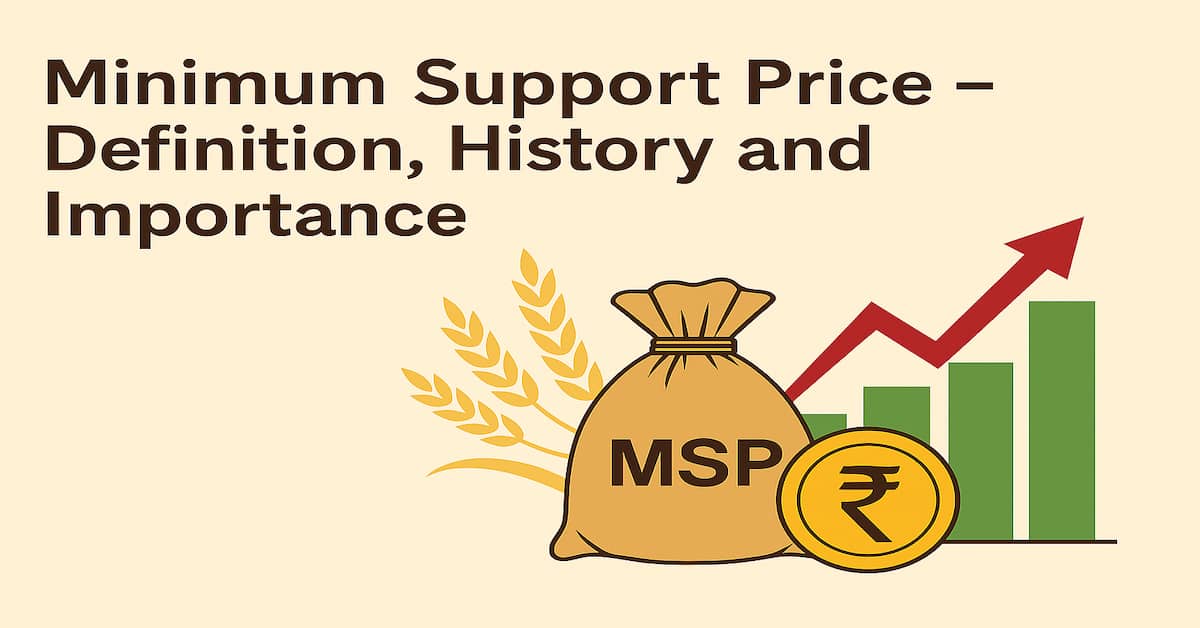Minimum Support Price is a very important part of India’s agricultural policy.
It gives farmers a safety net by making sure they get a fair price for their crops, even if market prices fall. It also helps protect the country’s food supply.
Table of Contents
- 1. Definition of Minimum Support Price (MSP)
- 2. Historical Background of MSP
- 3. How MSP Works- Simple Explanation
- 3.1. 1. Selection of Crops
- 3.2. 2. Price Announcement
- 3.3. 3. Fixing the price
- 3.4. 4. Buying the Crops
- 3.5. 5. Revision of MSP
- 4. Why MSP Is Important for Farmers and Indian Agriculture
- 4.1. 1. Protects Farmers
- 4.2. 2. Encourages Farming
- 4.3. 3. Farmers get more power
- 4.4. 4. Keeps Prices Stable
- 4.5. 5. Provides food grains
- 4.6. 6. Supports New Crops
- 4.7. 7. Helps Rural Areas Grow
- 5. Conclusion
Minimum Support Price has been both helpful and controversial. Many people have different views on how it works and who it helps. But why is it so important?
Minimum Support Price is like a promise from the government. It means that farmers can sell their crops at a fixed price, even if the market prices are low. This system started in the 1960s after a huge food shortage.
Leaders like C. Subramaniam gave it shape and it has remained important ever since.
In this blog we will explain what Minimum Support Price is, how it works, where it came from and how it affects farmers today.
Definition of Minimum Support Price (MSP)

Imagine you are a farmer growing wheat. You have invested time, money and effort – but if the prices in the market fall, you could lose everything. This is where the Minimum Support Price (MSP) comes into play.
MSP acts as a safety net for farmers. The government fixes minimum prices for crops like wheat, rice and pulses. If the prices in the market fall, the government buys the crop at this fixed price so that farmers do not suffer huge losses and get fair payment for their hard work.
You can check here MSP from 2014-15 to 2023-24 fixed by Central Government.
MSP helps farmers feel secure. They know they won’t lose money when they sell their produce. This helps them plan better, buy new equipment and grow more food.
Historical Background of MSP
The story of Minimum Support Price (MSP) in India is closely linked to how the country grows food and supports its farmers.
It all started in the 1960s when India did not have enough food and had to import it from other countries. That was the time of the Green Revolution, when India started using new types of seeds like dwarf wheat to grow more crops.
But farmers were not sure if they should use these new seeds. So, the government promised to buy their crops at a fixed price. This promise was called MSP. It first started in 1966-67 for wheat, and later for rice, pulses, and other crops.
In the 1970s and 1980s, MSP helped the country store more food grains and keep prices under control.
Later, in the 2000s, the focus of MSP shifted to helping farmers earn better returns and stabilise prices. The government included more crops under MSP and also started announcing prices more frequently.
How MSP Works- Simple Explanation
Let’s understand how it works step by step:
1. Selection of Crops
The government first decides which crops are important for the country – like wheat, rice, pulses, etc. These are selected because they are essential for food or are important for the economy.
2. Price Announcement
The government announces MSP for these crops twice a year. This means that the government promises to buy these crops at a certain minimum price.
3. Fixing the price
The MSP is fixed before farmers sow their crops. This helps them plan better. The MSP ensures that even if the market price falls later, farmers will continue to receive this minimum amount.
4. Buying the Crops
After harvesting the crop, farmers can sell their crop to the government at MSP. This is usually done in special markets called mandis. Government agencies like FCI (Food Corporation of India) buy the crop.
5. Revision of MSP
MSP is not the same every year. The MSP is usually revised annually or at least periodically, taking into account factors such as production costs, inflation, demand-supply dynamics, and international prices.
Why MSP Is Important for Farmers and Indian Agriculture
Minimum Support Price (MSP) plays a huge role in helping farmers and supporting agriculture in India. Here’s how it helps:
1. Protects Farmers
MSP acts as a safety net. Even if the prices in the market fall or the crops do not grow well, the farmers get a fixed price. This helps them avoid major losses. It also gives them the confidence to buy good seeds, fertilizers and equipment to grow more crops.
2. Encourages Farming
Since MSP promises a fair price, farmers feel secure in growing more crops – especially critical crops like wheat and rice. This helps India grow enough food for everyone.
3. Farmers get more power
When farmers are aware of MSP, they can negotiate better with traders. This helps them avoid fraud and demand a fair price. This means more income and a better life for them.
4. Keeps Prices Stable
MSP helps keep farming stable by stopping prices from falling too low. If prices go too low, farmers suffer and food supply gets affected. MSP helps keep things steady so farming stays strong.
5. Provides food grains
Under MSP, the government can buy crops like wheat and rice and store them. These are used in difficult times like drought or emergency. This keeps the food supply stable and secure.
6. Supports New Crops
Earlier, MSP was only for a few crops. Now it covers more crops like pulses, fruits and vegetables. This gives farmers an opportunity to try new things and grow a variety of crops. This helps in making farming better and more sustainable.
7. Helps Rural Areas Grow
When farmers earn more, they spend more in their villages – buying things from shops, hiring workers and building houses. This creates jobs and keeps rural areas active and growing.
Conclusion
Minimum Support Price is an important part of farming in India. It helps farmers get a fair price and keeps our food supply strong. MSP has done a lot of good, but now it needs some changes.
With things like climate change and new farming methods, MSP should also improve. We need to make it easier for farmers to sell their crops and use better, smarter ways to grow food. If we all work together, MSP can keep helping farmers and make farming better for the future.



